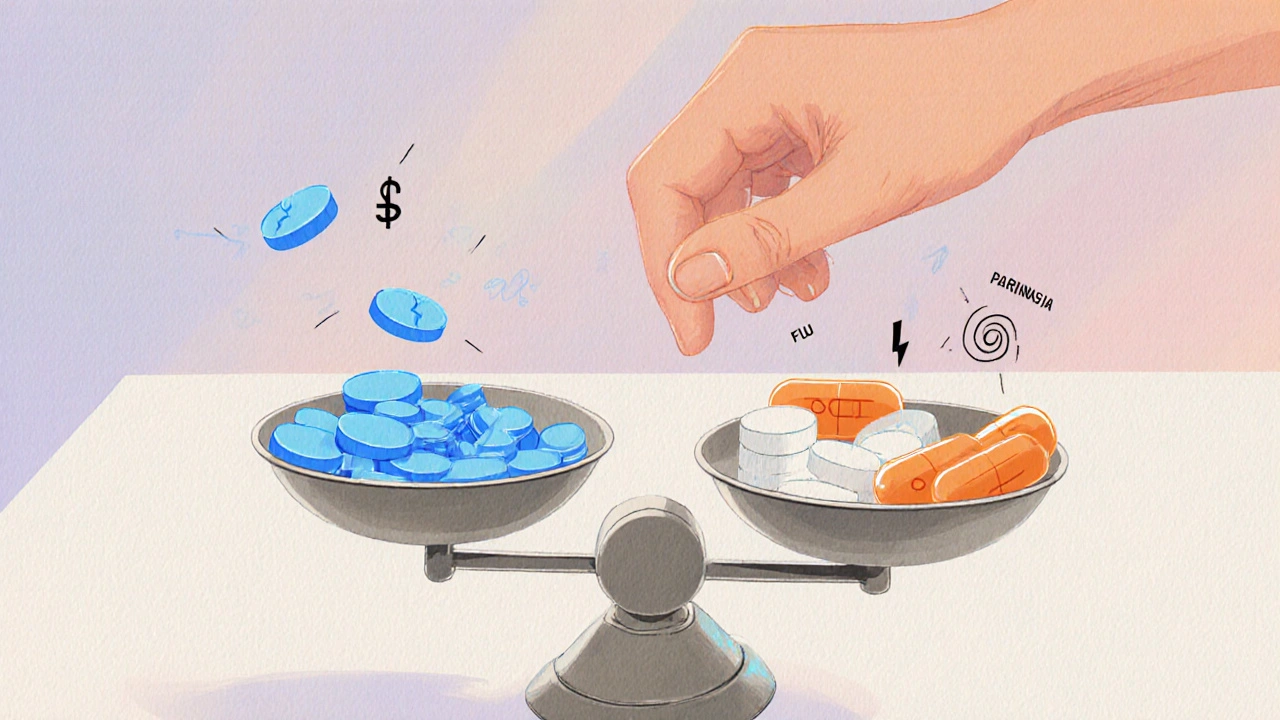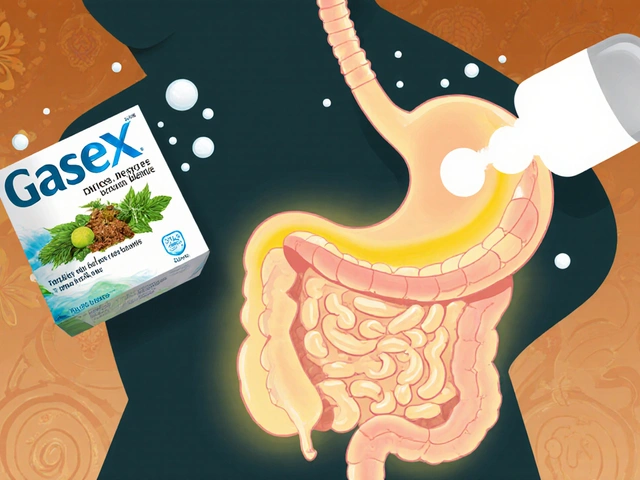Amantadine vs. Alternatives Comparison Tool
Select Condition
Select Current Medication
TL;DR
- Amantadine (Symmetrel) works for Parkinson’s symptoms and influenza A, but newer drugs often have better efficacy or fewer side effects.
- For Parkinson’s, levodopa/carbidopa, rasagiline and pramipexole are the most common switches.
- For flu, oseltamivir and zanamivir replace amantadine with broader strain coverage.
- Consider mechanism of action, side‑effect profile, dosing convenience and cost before switching.
- Always discuss changes with a prescriber; abrupt stops can worsen symptoms.
If you’re hunting for amantadine alternatives, you’ve come to the right place. This guide breaks down what makes Symmetrel tick, why you might look elsewhere, and how the top substitutes stack up for both movement‑disorder and antiviral needs.
What is Symmetrel (Amantadine)?
Amantadine is a synthetic tricyclic amine originally approved in 1966 for prevention and treatment of influenza A. In the late 1970s clinicians discovered it also eases mild to moderate Parkinson’s disease (PD) and mitigates drug‑induced extrapyramidal symptoms (EPS). It works by blocking the viral M2 ion channel and by increasing dopamine release while inhibiting its reuptake in the brain.
Typical adult dosing for PD is 100‑200mg daily, split into two doses; for flu prophylaxis it’s 200mg once daily. Common side effects include dry mouth, insomnia, dizziness, and livedo reticularis. Because it can lower the seizure threshold, patients with a history of seizures need caution.
Cost‑wise, generic amantadine tablets hover around AUD5‑10 per month in Australia, making it a budget‑friendly option. However, the drug’s efficacy for flu has waned as resistant influenza A strains spread, and newer PD agents often deliver smoother motor control.
Why Look for Alternatives?
There are three main reasons patients and doctors consider switching:
- Resistance or limited effectiveness - Influenza A viruses with the S31N mutation are now largely immune to amantadine.
- Side‑effect burden - Cognitive fog, orthostatic hypotension, and vivid dreams can affect quality of life.
- Therapeutic goals - Advanced PD may need stronger dopaminergic stimulation than amantadine provides.
Below we compare the most widely used substitutes, grouped by the indication you’re targeting.
Parkinson’s‑Focused Alternatives
When the goal is motor symptom control, the following agents dominate modern practice:
Levodopa/Carbidopa is a combination that delivers the dopamine precursor levodopa while carbidopa blocks peripheral conversion, allowing more drug to reach the brain
Rasagiline is a selective monoamine oxidase‑B (MAO‑B) inhibitor that slows dopamine breakdown, approved for early‑stage PD and as adjunct therapy
Selegiline is another MAO‑B inhibitor, traditionally used at lower doses for neuroprotection and at higher doses as a levodopa‑sparing agent
Bromocriptine is a ergot‑derived dopamine agonist that stimulates D2 receptors, useful for patients who cannot tolerate levodopa
Pramipexole is a non‑ergot dopamine agonist with a long half‑life, often started in early PD or used for restless‑leg syndrome
How These Fit Against Amantadine
- Mechanism: Amantadine boosts dopamine release; the alternatives either supply dopamine (levodopa) or directly stimulate receptors (agonists) or protect dopamine (MAO‑B inhibitors).
- Efficacy: Levodopa remains the gold standard for motor control; MAO‑B inhibitors provide modest but steady improvement with fewer motor fluctuations.
- Side‑effects: Levodopa can cause dyskinesia over time; dopamine agonists may lead to impulse‑control disorders; MAO‑B inhibitors are generally well‑tolerated but can interact with certain antidepressants.
- Convenience: Once‑daily dosing for rasagiline and pramipexole simplifies regimens, whereas amantadine often needs split doses.
- Cost (Australia): Generic levodopa/carbidopa is cheap (≈AUD8/month), rasagiline and pramipexole are pricier (≈AUD70‑120/month), but many are subsidised under PBS.
Antiviral Alternatives for Influenza A
For viral indications, the field has moved beyond the M2‑channel blockers.
Oseltamivir is a neuraminidase inhibitor taken as a capsule (Tamiflu) that blocks viral release from infected cells
Zanamivir is an inhaled neuraminidase inhibitor (Relenza) offering a needle‑free option for those with swallowing difficulties
Why Switch from Amantadine?
- Resistance profile: Oseltamivir and zanamivir retain activity against virtually all circulating influenza A and B strains, while amantadine resistance now exceeds 90% globally.
- Clinical outcomes: Neuraminidase inhibitors reduce symptom duration by ~1‑2 days and lower complication rates, especially in high‑risk groups.
- Safety: Oseltamivir’s most common side effects are nausea and headache; zanamivir’s inhalation can cause bronchospasm but is otherwise well‑tolerated.
- Dosing: Both are once‑daily for prophylaxis (oseltamivir) or twice‑daily for treatment (7‑day course), simplifying adherence compared with amantadine’s daily dosing.
- Cost: Generic oseltamivir tablets cost ~AUD15‑25 for a five‑day pack; zanamivir (inhaler) is pricier (~AUD80 for a five‑day supply) but may be covered for high‑risk patients.

Other Off‑Label Uses and Their Substitutes
Amantadine is sometimes prescribed for post‑concussion fatigue, multiple sclerosis (MS) fatigue, and drug‑induced dyskinesia. Alternatives differ by condition:
- MS fatigue: Modafinil or armodafinil provide wake‑promoting effects with a more predictable side‑effect profile.
- Traumatic brain injury (TBI) fatigue: Methylphenidate is frequently used; studies show modest improvement in alertness.
- Drug‑induced dyskinesia: Reducing dopaminergic load or adding a MAO‑B inhibitor (rasagiline) can help; clozapine is used in severe cases.
Decision‑Making Checklist
Before you or your clinician decide to switch, run through this quick list:
- Identify the primary indication (Parkinson’s vs. flu vs. off‑label).
- Check for drug‑resistance (influenza strain testing) or disease stage (early vs. advanced PD).
- List current side effects that are intolerable.
- Consider comorbidities (e.g., cardiac disease, asthma) that may limit certain alternatives.
- Review insurance or PBS coverage for the substitute.
- Plan a taper schedule if stopping amantadine to avoid rebound symptoms.
Comparison Table: Key Attributes
| Drug | Class | Primary Indication | Mechanism | Typical Dose | Common Side‑effects | Cost (AUD/month) |
|---|---|---|---|---|---|---|
| Amantadine | Tricyclic amine | PD, Influenza A | Dopamine release ↑; M2 ion‑channel block | 100‑200mg daily | Dizziness, insomnia, livedo | 5‑10 |
| Levodopa/Carbidopa | Precursor + enzyme inhibitor | PD | Converts to dopamine in CNS | 300‑600mg daily split | Nausea, dyskinesia | 8‑12 |
| Rasagiline | MAO‑B inhibitor | Early PD | Blocks dopamine breakdown | 1mg daily | Headache, hypertension | 70‑90 (subsidised) |
| Oseltamivir | Neuraminidase inhibitor | Influenza A/B | Prevents viral release | 75mg twice daily (5 days) | Nausea, vomiting | 15‑25 (5‑day pack) |
| Zanamivir | Inhaled neuraminidase inhibitor | Influenza A/B | Inhibits viral release in airway | 2 inhalations twice daily (5 days) | Bronchospasm, throat irritation | 80‑100 (5‑day supply) |
| Pramipexole | Dopamine agonist | PD, RLS | Stimulates D2/D3 receptors | 0.125‑0.5mg three times | Somnolence, impulse control | 90‑120 (subsidised) |
Best‑Fit Scenarios
- For early‑stage PD with mild symptoms: rasagiline or pramipexole provide smooth control without the dyskinesia risk of levodopa.
- For advanced PD requiring strong motor boost: levodopa/carbidopa remains unbeatable; consider adding amantadine only if dyskinesia is already an issue.
- For flu prophylaxis during an outbreak: oseltamivir outperforms amantadine in both effectiveness and resistance avoidance.
- For patients with asthma who can’t inhale: oral oseltamivir is the safest choice.
- When cost is the primary barrier: generic amantadine still wins for PD, but for flu the cheap generic versions of oseltamivir are competitive.
Potential Pitfalls When Switching
Changing medications isn’t always a clean cut. Watch out for:
- Rebound motor symptoms - taper amantadine over 1‑2 weeks if you’re moving to levodopa.
- Drug‑drug interactions - MAO‑B inhibitors can combine dangerously with certain antidepressants (e.g., SSRIs).
- Allergic reactions - especially with inhaled zanamivir in patients with reactive airway disease.
- Insurance gaps - newer agents may need prior authorization; check PBS listings before prescribing.
Next Steps & Troubleshooting
If you’ve identified a preferable alternative, follow this simple workflow:
- Schedule a consultation with your neurologist or GP and bring this comparison table.
- Confirm the indication matches (PD vs. flu vs. off‑label).
- Ask about a tapering plan for amantadine to avoid withdrawal or symptom flare.
- Request a PBS subsidy form or pharmacy check for the chosen drug.
- Monitor symptoms for two weeks; keep a symptom diary to discuss any new side effects.
Should unexpected side effects arise, contact your prescriber immediately. In most cases, a dose adjustment or a switch to another agent resolves the issue.

Frequently Asked Questions
Is amantadine still effective against the flu?
No. Over 90% of circulating influenza A strains carry the S31N mutation, rendering amantadine ineffective. Neuraminidase inhibitors like oseltamivir are the recommended choice.
Can I take amantadine and a MAO‑B inhibitor together?
Generally you should avoid the combination because both increase dopamine levels and can cause excessive stimulation or hypertension. Talk to your doctor before mixing them.
What’s the biggest advantage of pramipexole over amantadine?
Pramipexole directly stimulates dopamine receptors, delivering more consistent motor improvement, especially in early‑stage Parkinson’s, without the need for split dosing.
Are there any natural alternatives to amantadine for fatigue?
Lifestyle changes (regular sleep schedule, exercise) help, but pharmaceutically, modafinil or armodafinil are the most evidence‑based non‑amphetamine options for fatigue.
How should I taper off amantadine?
A typical taper reduces the dose by 50% every 5‑7 days (e.g., 200mg → 100mg → 50mg) while monitoring for rebound Parkinsonian symptoms. Your clinician may adjust the schedule based on your response.




September 29, 2025 AT 22:04 PM
Hey there, I see you’ve put together a solid overview of amantadine and its alternatives. If you’re weighing a switch, start by listing which side effects are most bothersome for you. A quick note: tapering amantadine gradually can help avoid a rebound in Parkinsonian symptoms.
September 30, 2025 AT 23:04 PM
Great summary! 👍 For flu, the resistance issue with amantadine is a big deal-oseltamivir usually covers both A and B strains. If cost is a concern, check if your pharmacy offers a generic version; it’s often cheaper than the branded pack.
October 2, 2025 AT 00:04 AM
In reviewing the comparative data, one observes that levodopa/carbidopa remains the gold‑standard for motor control in Parkinson’s disease; however, its long‑term use is frequently accompanied by dyskinesia, nausea, and dose‑dependent fluctuations, which patients should monitor closely. Conversely, MAO‑B inhibitors such as rasagiline present a modest benefit with a comparatively favorable side‑effect profile, albeit at a higher expense. It is advisable to discuss these trade‑offs with a neurologist before initiating any regimen change.
October 3, 2025 AT 01:04 AM
When contemplating the transition from amantadine to another therapeutic agent, it is essential to adopt a holistic perspective that transcends the mere pharmacologic mechanisms. Firstly, the stage of Parkinson’s disease dictates the therapeutic ceiling; early‑stage patients often derive sufficient benefit from MAO‑B inhibition, whereas advanced stages may necessitate the robust dopaminergic surge provided by levodopa/carbidopa. Secondly, one must weigh the adverse‑effect burden: while amantadine’s side‑effects such as insomnia and livedo reticularis are generally tolerable, the dyskinesia associated with levodopa can be socially disabling. Thirdly, economic considerations bear weight, as the subsidised PBS pricing of rasagiline and pramipexole may obviate the allure of a low‑cost generic; nevertheless, out‑of‑pocket expenses can still accumulate for patients without comprehensive coverage. Fourthly, the risk of viral resistance renders amantadine largely obsolete for influenza prophylaxis, compelling clinicians to prefer neuraminidase inhibitors, which consistently demonstrate efficacy across influenza A and B strains. Fifthly, comorbid conditions such as cardiac arrhythmias, respiratory compromise, or psychiatric disorders may contraindicate certain alternatives; for example, dopamine agonists can aggravate impulse‑control disorders in susceptible individuals. Sixthly, the pharmacokinetic profiles differ: oseltamivir requires twice‑daily dosing for treatment, while zanamivir’s inhaled route may be unsuitable for asthmatic patients. Seventhly, patient preference regarding administration route-oral versus inhaled-should be accommodated whenever feasible, as adherence tends to improve with convenience. Eighthly, vigilance for drug‑drug interactions is paramount, especially when considering MAO‑B inhibitors alongside SSRIs or SNRIs, which can precipitate hypertensive crises. Ninthly, a systematic taper of amantadine, typically reducing the dose by 50 % over a one‑to‑two‑week interval, mitigates the risk of rebound motor worsening. Tenthly, longitudinal monitoring using tools such as the UPDRS (Unified Parkinson’s Disease Rating Scale) can objectively track therapeutic response and guide dosage adjustments. Eleventhly, involving multidisciplinary teams-including pharmacists, physiotherapists, and speech therapists-enhances holistic care. Twelfthly, education regarding potential side effects empowers patients to report adverse events promptly. Thirteenthly, regular reassessment at three‑ to six‑month intervals ensures that the chosen regimen remains optimal as disease progression unfolds. Fourteenthly, insurance pre‑authorisation processes may introduce delays; proactive coordination with providers can alleviate such barriers. Finally, maintaining an open dialogue with the prescribing clinician fosters a therapeutic alliance that is crucial for navigating the complexities of Parkinson’s disease management.
October 4, 2025 AT 02:04 AM
Whoa, that was an epic deep‑dive! I totally get the drama of switching meds-sometimes it feels like you’re juggling a circus of side‑effects, costs, and that annoying resistance thing. Just remember, you don’t have to do it all at once; take it step by step, and keep an eye on how you feel each day.
October 5, 2025 AT 03:04 AM
From a pharmacologic standpoint, the shift toward dopamine agonists such as pramipexole introduces receptor‑specific activation, which can streamline motor control without the metabolic fluctuations seen in levodopa therapy. In practice, integrating a long‑acting formulation can reduce dosing frequency, thereby improving adherence metrics across patient cohorts.
October 6, 2025 AT 04:04 AM
Ah, the siren song of “newer is better” – it often masks the fact that every molecule carries its own brand of baggage. Take rasagiline, for instance: while it boasts a sleek monodose and a polished side‑effect tableau, it also lures patients into a false sense of invincibility, masking the latent risk of hypertensive spikes when paired with serotonergic agents. And let's not forget the cultural inertia that keeps many prescribers tethered to the tried‑and‑true levodopa, despite its reputation for dyskinesia. The economics too, dance a mischievous jig; a subsidised drug may appear as a charitable offering, yet hidden co‑pay structures can erode that illusion faster than a neon sign flickers out in a storm. Moreover, the very definition of “efficacy” is a moving target, reshaped by patient expectations, trial designs, and the inevitable bias of publication. So, before you crown any alternative as the ultimate champion, consider the full mosaic: pharmacodynamics, patient lifestyle, health‑system logistics, and the ever‑present spectre of side‑effect surprise. In short, the best choice is often the one that fits your personal narrative, not the one that glitters on a spreadsheet.
October 7, 2025 AT 05:04 AM
Great points! I’d add that for flu prophylaxis, the data clearly show oseltamivir’s superiority over amantadine, especially given the high resistance rates. If cost is a hurdle, many community health centers provide discounted courses, so it’s worth checking local resources.
October 8, 2025 AT 06:04 AM
Switching meds can feel like stepping off a cliff-thrilling, terrifying, and totally binge‑worthy.
October 9, 2025 AT 07:04 AM
Amantadine is cheap but largely ineffective against modern influenza strains.
October 10, 2025 AT 08:04 AM
💡 Absolutely! The “cliff” metaphor captures the uncertainty, but a well‑planned taper and monitoring can turn that plunge into a graceful glide. Keep a symptom diary, and don’t hesitate to reach out to your neurologist if anything feels off.
October 11, 2025 AT 09:04 AM
Look, if you’re on a budget and your PD symptoms are mild, amantadine might still do the trick-just watch for those insomnia nights and keep an eye on any weird skin changes. On the flip side, the newer drugs can be pricey, so weigh the pros and cons before pulling the trigger on a switch.
October 12, 2025 AT 10:04 AM
In my experience, the decision matrix for transitioning from amantadine involves multiple layers: clinical efficacy, side‑effect tolerability, financial accessibility, and patient‑centered goals. It is crucial to engage in shared decision‑making, perhaps by drafting a table that juxtaposes each alternative across these domains. Such a systematic approach not only clarifies priorities but also empowers patients to voice preferences that might otherwise be overlooked in a hurried clinical encounter. Additionally, longitudinal follow‑up-ideally at three‑month intervals-provides a feedback loop to reassess the chosen therapy’s impact on both motor and non‑motor symptoms, ultimately guiding fine‑tuning of the regimen over time.